A password will be e-mailed to you

Reset Password

More information
Image gallery, floor plans.

Use the form below to contact us!

This pocket cruiser and popular club racer is built for speed and comfort
Opinions vary widely when talk turns to the Tanzer 26, the Canadian-built masthead sloop that was popular in 1970s and 1980s. Some sailors contend the recreational sailboat offers just about everything you might want in a small package—simple rigging, rugged construction, ample room below deck, cruising capability and, surprisingly, speed. Detractors say the boat lacks style and is more akin to a plastic bleach bottle with an unpleasing squatty profile.
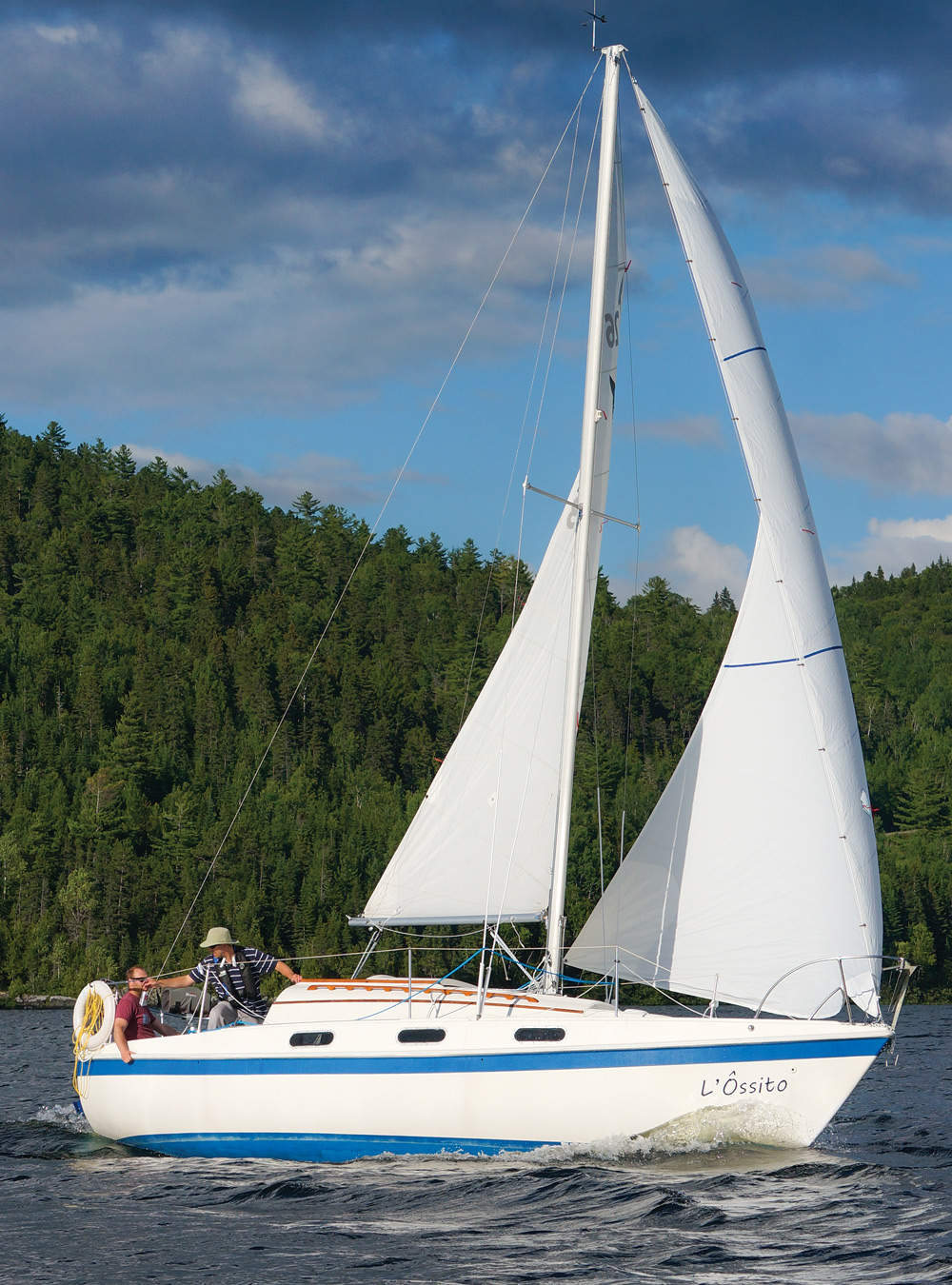
Designed by Johann Tanzer, the boat enjoyed a 10-year production run starting in 1975 at the Tanzer Industries Vaudreuil plant in Dorion, Quebec. With 960 T26s built, the company went out of production in May 1986 when Tanzer Industries filed for bankruptcy.
During those two decades, the company also built 2,270 Tanzer 22s, its most successful model, which emerged as a popular club racer. Tanzer first found success in 1958 with its Flying Scot and over the years the company churned out approximately 8,000 boats in several lengths, up to 34 feet.
According to T26 owners, the boat offers qualities that will appeal to cruising families as well as racing skippers. As the Tanzer 26 website puts it, “She provides both speed and responsiveness that is quite unusual for a production boat. But she is not just a fast sailboat that wins races. Her expansive and comfortable interior as well as forgiving nature make her a safe and easily handled cruising boat for the family.”
First impressions
When discussing the merits of form versus function, the Tanzer 26 could easily be lumped in with the latter. Not the prettiest girl at the dance, the compact pocket cruiser nonetheless has many admirers. It’s a boat absent of traditional sheer, graceful overhangs, or even the openness of a race boat. In two words, the Tanzer 26 is practical and affordable, and that’s what attracts so many sailors.
Construction
Although the majority of Tanzer boats were built at the home base near Montreal, others were produced in Edenton, North Carolina, and Arlington, Washington, during the height of the company’s success.
The T26 hull is constructed as a single unit in hand-laid fiberglass with alternate layers of woven roving and mat. Additional layers are applied in high-stress areas. The deck, cabintop and cockpit are also constructed as a single unit, reinforced by sandwich construction to help ensure a rigid, insulated, non-flexing deck.
Latter models featured longer exterior handrails, nonskid deck, and a portal configuration with a single, long window on each side of the cabintrunk, replacing the former array of three or four portals per side.
The boat has a fiberglass hull, fin keel with a draft of 3 feet, 10 inches and transom-hung rudder. Tanzer offered a shoal-draft model as a factory option with a keel draft of 2 feet, 8 inches.
Also in Used Boat Notebook
- Hunter Vision 32
- Hunter Passage 42
- Pearson Rhodes 41
- Santa Cruz 52
- Allied Princess 36
Also from David Liscio
- Chasing a dream
- The wide, wide world of multihulls
- Flares are expired. Now what?
- Saved from the scrap heap
- Pedal to the Medal

The Tanzer 26 is a 26.33ft masthead sloop designed by Johann Tanzer and built in fiberglass by Tanzer Industries Ltd. between 1974 and 1985.
960 units have been built..
The Tanzer 26 is a light sailboat which is a reasonably good performer. It is very stable / stiff and has a low righting capability if capsized. It is best suited as a day-boat.

Tanzer 26 for sale elsewhere on the web:

Main features
| Model | Tanzer 26 | | |
| Length | 26.33 ft | | |
| Beam | 8.67 ft | | |
| Draft | 3.83 ft | | |
| Country | Canada (North America) | | |
| Estimated price | $ 0 | | ?? |
Login or register to personnalize this screen.
You will be able to pin external links of your choice.

See how Sailboatlab works in video
| Sail area / displ. | 16.98 | | |
| Ballast / displ. | 44.83 % | | |
| Displ. / length | 170.49 | | |
| Comfort ratio | 16 | | |
| Capsize | 2.13 | | |
| Hull type | Monohull fin keel with transom hung rudder | | |
| Construction | Fiberglass | | |
| Waterline length | 22.50 ft | | |
| Maximum draft | 3.83 ft | | |
| Displacement | 4350 lbs | | |
| Ballast | 1950 lbs | | |
| Hull speed | 6.36 knots | | |

We help you build your own hydraulic steering system - Lecomble & Schmitt
| Rigging | Masthead Sloop | | |
| Sail area (100%) | 282 sq.ft | | |
| Air draft | 33 ft | | |
| Sail area fore | 159.49 sq.ft | | |
| Sail area main | 129.41 sq.ft | | |
| I | 30.15 ft | | |
| J | 10.58 ft | | |
| P | 25.25 ft | | |
| E | 10.25 ft | | |
| Nb engines | 1 | | |
| Total power | 0 HP | | |
| Fuel capacity | 0 gals | | |
Accommodations
| Water capacity | 0 gals | | |
| Headroom | 0 ft | | |
| Nb of cabins | 0 | | |
| Nb of berths | 0 | | |
| Nb heads | 0 | | |
Builder data
| Builder | Tanzer Industries Ltd. | | |
| Designer | Johann Tanzer | | |
| First built | 1974 | | |
| Last built | 1985 | | |
| Number built | 960 | | |
Other photos
Modal title.
The content of your modal.
Personalize your sailboat data sheet
Paste a link here:
Give it a title:
And eventually a link to an image for the thumbnail:
Review of tanzer 26
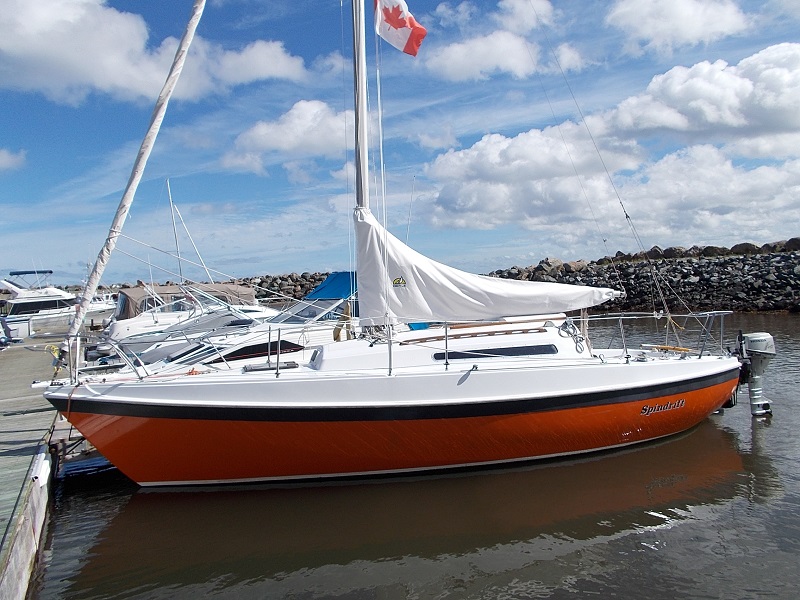
Basic specs.
The hull is made of fibreglass. Generally, a hull made of fibreglass requires only a minimum of maintenance during the sailing season. And outside the sailing season, just bottom cleaning and perhaps anti-fouling painting once a year - a few hours of work, that's all.

The tanzer 26 is equipped with a fin keel. The fin keel is the most common keel and provides splendid manoeuvrability. The downside is that it has less directional stability than a long keel.
The boat can enter even shallow marinas as the draft is just about 1.17 - 1.27 meter (3.84 - 4.14 ft) dependent on the load. See immersion rate below.
Sailing characteristics
This section covers widely used rules of thumb to describe the sailing characteristics. Please note that even though the calculations are correct, the interpretation of the results might not be valid for extreme boats.
What is Capsize Screening Formula (CSF)?
The capsize screening value for tanzer 26 is 2.12, indicating that this boat would not be accepted to participate in ocean races.
What is Theoretical Maximum Hull Speed?
The theoretical maximal speed of a displacement boat of this length is 6.4 knots. The term "Theoretical Maximum Hull Speed" is widely used even though a boat can sail faster. The term shall be interpreted as above the theoretical speed a great additional power is necessary for a small gain in speed.
The immersion rate is defined as the weight required to sink the boat a certain level. The immersion rate for tanzer 26 is about 121 kg/cm, alternatively 679 lbs/inch. Meaning: if you load 121 kg cargo on the boat then it will sink 1 cm. Alternatively, if you load 679 lbs cargo on the boat it will sink 1 inch.
Sailing statistics
This section is statistical comparison with similar boats of the same category. The basis of the following statistical computations is our unique database with more than 26,000 different boat types and 350,000 data points.
What is Motion Comfort Ratio (MCR)?
What is L/B (Length Beam Ratio)?
What is a Ballast Ratio?
What is Displacement Length Ratio?
What is SA/D (Sail Area Displacement ratio)?
Maintenance
When buying anti-fouling bottom paint, it's nice to know how much to buy. The surface of the wet bottom is about 20m 2 (215 ft 2 ). Based on this, your favourite maritime shop can tell you the quantity you need.
Are your sails worn out? You might find your next sail here: Sails for Sale
If you need to renew parts of your running rig and is not quite sure of the dimensions, you may find the estimates computed below useful.
| Usage | Length | Diameter |
| Mainsail halyard | 20.5 m | (67.3 feet) | 8 mm | (5/16 inch) |
| Jib/genoa halyard | 20.5 m | (67.3 feet) | 8 mm | (5/16 inch) |
| Spinnaker halyard | 20.5 m | (67.3 feet) | 8 mm | (5/16 inch) |
| Jib sheet | 8.0 m | (26.3 feet) | 10 mm | (3/8 inch) |
| Genoa sheet | 8.0 m | (26.3 feet) | 10 mm | (3/8 inch) |
| Mainsheet | 20.1 m | (65.9 feet) | 10 mm | (3/8 inch) |
| Spinnaker sheet | 17.7 m | (58.0 feet) | 10 mm | (3/8 inch) |
| Cunningham | 3.1 m | (10.3 feet) | 8 mm | (5/16 inch) |
| Kickingstrap | 6.3 m | (20.6 feet) | 8 mm | (5/16 inch) |
| Clew-outhaul | 6.3 m | (20.6 feet) | 8 mm | (5/16 inch) |
This section is reserved boat owner's modifications, improvements, etc. Here you might find (or contribute with) inspiration for your boat.
Do you have changes/improvements you would like to share? Upload a photo and describe what you have done.
We are always looking for new photos. If you can contribute with photos for tanzer 26 it would be a great help.
If you have any comments to the review, improvement suggestions, or the like, feel free to contact us . Criticism helps us to improve.
× You are using an outdated browser. Please upgrade your browser to improve your experience.
We Ship Worldwide! | FREE SHIPPING! for US Continental orders over $99. Click for details.

Shopping Cart
Your cart is currently empty..
FREE SHIPPING! for US Continental orders over $99 click for details
Tanzer 26 - Sailboat Data, Parts & Rigging

Sailboat data, rig dimensions and recommended sail areas for Tanzer 26 sailboat. Tech info about rigging, halyards, sheets, mainsail covers and more.
Sailboat Data directory for over 8,000 sailboat designs and manufacturers. Direct access to halyards lengths, recommended sail areas, mainsail cover styles, standing rigging fittings, and lots more for all cruising and racing sailboats.
MAURIPRO Sailing offers a full range of sailboat and sailing information to help you find the correct sailboat part, one that properly would fit your sailboat and sailing style. Our sailor's and sailboat owner support team are ready to talk with you about your specific sailing needs, coming regatta, or next sailing adventure.
From all at MAURIPRO, let's Go Sailing!
Copyright © 2024 MAURIPRO Sailing LLC.
- Choose the kind of boat Big boats Motor boats Rubber boats Sailing boats Sailing multihull boats
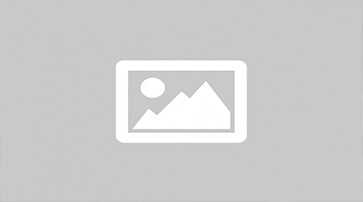
General Data
Shipbuilder:, see also: boats for sale.
- Ceccarelli EC8
- Maxi Dolphin Joker 81
- MC GREGOR FLORIDA MC GREGOR 26X
- Neptune Neptune 77
Overall length:
Waterline length:, maximum beam:, displacement:, straightening:, sail details mq.

Differences between the
"old" and "new" Tanzer 26's
My Tanzer 26 was built in 1975 and is one of the older models (Sail #28). I have noticed that people are often surprised by the differences between this older model and the newer Tanzer 26's. As a result, I thought it would be worthwhile to review the production history of the T26 and point out some of the differences between earlier and more recent models.
The Tanzer 26 was designed in 1974 and close to a thousand were built before the model was phased out in 1985. For all practical purposes, the Tanzer 26 remained essentially the same boat throughout its production run, although a design update in 1978-79 resulted in a number of noticeable changes - the most prominent being a new window configuration. I would estimate that a little over 200 of the older designs were built, meaning that the newer model constitutes the vast majority of T26's that made it out of the Tanzer factory.
It is also interesting to note that while most Tanzers were manufactured at the company's home base in Dorion, Quebec (a Montreal suburb), they were also produced in Edenton, North Carolina, and Arlington, Washington. I'm not clear if the Tanzer 26 was built in both US locations. A New Window Configuration
As already mentioned, a new window configuration was introduced with the new model. It consists of a single long window on each side of the raised trunk cabin, while the older models have 4 windows (the same portlights found on the Tanzer 22) on each side of the boat in the area between the deck top and the rubrail. This arrangement means the older models have a total of 4 windows in the main cabin, 2 in the head, and 2 in the V-berth compartment. Note that some of the older T26's were also built with only 3 windows on each side. I believe (but I'm not sure) that this 3 window configuration was more common on boats built in the United States.
From the exterior, I prefer the appearance of the long window on each side of the trunk cabin. This arrangement also frees up the space needed to apply the boat's name in the area between the deck top and rubrail (which I think adds a touch of class to the T26's). However, from the interior, I'm partial to the window configuration found on the older models. On my boat, for example, it's possible to survey the going-ons in the anchorage while comfortably seated in the main cabin (or on the head, for that matter). Moreover, my kids like the windows in the V-berth because it allows them to check what's happening outside without having to stick their heads out of the hatch (which is usually screened in when we are sleeping for the night). A Better Hatch
The forward hatch is one area where there has been a definite upgrade. The newer T26's are equipped with aluminum-framed polycarbonate (smoked plexiglass) hatches - versus - the heavy solid fiberglass hatches that come with the older models. Many people have installed a clear ventilator in these pre-historic fiberglass hatches. A by-product of the newer hatch arrangement is that it frees up the forward facing wall of the trunk cabin. Tanzer wisely installed an opening port in this spot - which is great for added ventilation.
Other differences between the older and newer models include exterior handrails that are about a foot and half longer on the earlier Tanzer 26's. Furthermore, the older models have recessed mainsheet travelers, a feature which makes it a little more comfortable to sit in the forward corners of the cockpit. On the other side of the coin, the newer models have non-skid surface on the narrow portion of the deck on each side of the cockpit (what could be considered the top of the cockpit coamings). This is a sorely missing feature on the older designs. Interior Differences
The interior also has a number of noteworthy differences. The newer T26's have better access to the V-berth compartment, including a cut away that allows people to "step into" the forward cabin. On these boats a curtain is used to separate the head from the V-berth area.
By comparison, the V-berth in the older T26's have no cut away, but can be completely closed off from the rest of the boat with 2 sliding doors. This arrangement clearly provides more privacy from the head than a curtain, and our kids like the fact that they can close off the forward cabin to create their "own" room. However I find that the lack of a cut away and the frames which support the sliding door restrict easy access to the V-berth area.
It should be noted that when the filler cushion is inserted in the cut away, the V-berths on the newer and older models provide the same amount of sleeping room.
Our 1975 Tanzer has a sink and hand pump unit which slides out from behind the head. I'm not sure if this was a standard feature on the older models, or simply an option which was ordered with our particular boat. A Starboard Berth
The main cabin of the older boats has a feature that often surprises owners of the newer models. There's room to sleep an adult on the starboard settee. This is accomplished by having a slightly smaller galley area, and a foot well for the sleeping individual which extends under the counter. This arrangement means the stove is mounted on top of the galley counter.
On the newer T26's the galley is slightly larger and has an opening which allows the stove to be installed at counter height. However, this eliminates the space for the foot well, and the final result is a starboard settee that is only large enough to sit two people. Personally, I don't like this arrangement, but it is a feature which is also found on larger Tanzers, including the Tanzer 8.5 (a 28 footer) and Tanzer 31. It should also be noted that on the newer models, the back rest of the starboard settee is a board which folds up to form a chart table.
Because of the lack of a berth on the starboard settee, the newer T26's have a port settee that converts into a double berth. With a little ingenuity, it's fairly easy to implement the same arrangement on the older Tanzers. Veneer Finishes
I have also noticed that the table which folds against the bulkhead is a little longer on my boat than what I have seen on the more recent T26's. Additionally, the main bulkhead on my boat is finished with a teak veneer. It certainly looks a lot nicer than the simulated wood grain vinyl found on later Tanzers, but I can't help notice that I'm bragging about having a real veneer finish.
Another difference is that the area under the companionway ladder is wide open on the older models. While this makes it easy to store large items in this part of the boat, it also means everything remains visible from the main cabin. On the newer T26's, this area is enclosed, but the space is accessible through two reasonably large doors.
A final word - I should again emphasize that the Tanzer 26 has remained essentially the same boat throughout its production run. With the possible exception of the windows, most of the differences I have pointed out would probably not be noticed by the casual observer looking at the older and newer models for the first time. Written by Michael McGoldrick . © Michael McGoldrick, 1998.

Great choice! Your favorites are temporarily saved for this session. Sign in to save them permanently, access them on any device, and receive relevant alerts.
Tanzer Industries Ltd.
Founded by Johann Tanzer, Tanzer Industries Ltd. was one of the largest sailboat manufacturer in Canada for more than 20 years. The Tanzer line ranged from 16 to 35 feet. The most successful model was the TANZER 22 with more than 2200 built. But other models including the 26 were also built in large numbers. In it’s heyday Tanzer built boats on both coasts of the U.S., but the factory at Dorion, Que., turned out the bulk of the roughly 8,000 Tanzers built. The company was forced into bankruptcy in May of 1986.
Associations
- Quarter Ton Class
- Tanzer 16 Class Association
- Flying Scott (USA)
- C&C Design
- Dick Carter
- Gordon K. (Sandy) Douglass
- Johann Tanzer
- Johan Tanzer
- Johnson/Melges Boat Works
- Joubert-Nivelt
- Raymond Hunt (C.R. Hunt & Assoc.)
- William Shaw
20 sailboats built by Tanzer Industries Ltd.

Flying Scot

Overnighter 16
Tanzer 22 cb.

Constellation 16

Tanzer 10.5

Tanzer 22 T/4

©2024 Sea Time Tech, LLC
This site is protected by reCAPTCHA and the Google Privacy Policy and Terms of Service apply.
|
|
". I can attest to that. I have been out on the bay in 50 knot winds (storm jib, reefed main Oct. 2011) and she took it in stride. After an off-season of paint, polish and elbow grease, she was a sight to behold (slight bias).
|
|
| |
The Demise of Tanzer Industries. An article about the final days of Tanzer Industries.
Sailquest's T26 Review A high level review/assessment of the T26.
Avocet - Chrysler 26 vs. T26 A Chrysler 26 compared to the T26.
Tale of Two Tanzers - T26 and 7.5 compared.
Brewer by the Numbers - What's the meaning of all those numbers used by yacht designers? This Good Old Boat article is an excellent read.
Brewer Yacht Design - Ted Brewer's site, promoting his book and giving good information.
The Alradee-Chi
A 1976 Tanzer 26
The list of 2010-2011 Winter/Spring projects; completed, underway, planned...
Past upgrades:
- New Sailboats
- Sailboats 21-30ft
- Sailboats 31-35ft
- Sailboats 36-40ft
- Sailboats Over 40ft
- Sailboats Under 21feet
- used_sailboats
- Apps and Computer Programs
- Communications
- Fishfinders
- Handheld Electronics
- Plotters MFDS Rradar
- Wind, Speed & Depth Instruments
- Anchoring Mooring
- Running Rigging
- Sails Canvas
- Standing Rigging
- Diesel Engines
- Off Grid Energy
- Cleaning Waxing
- DIY Projects
- Repair, Tools & Materials
- Spare Parts
- Tools & Gadgets
- Cabin Comfort
- Ventilation
- Footwear Apparel
- Foul Weather Gear
- Mailport & PS Advisor
- Inside Practical Sailor Blog
- Activate My Web Access
- Reset Password
- Customer Service


Catalina 270 vs. The Beneteau First 265 Used Boat Match-Up

Ericson 41 Used Boat Review

Mason 33 Used Boat Review

Beneteau 311, Catalina 310 and Hunter 326 Used Boat Comparison

Tips From A First “Sail” on the ICW


Tillerpilot Tips and Safety Cautions

Best Crimpers and Strippers for Fixing Marine Electrical Connectors

Thinking Through a Solar Power Installation

Polyester vs. Nylon Rode

Getting the Most Out of Older Sails

How (Not) to Tie Your Boat to a Dock

Stopping Mainsheet Twist

Fuel Lift Pump: Easy DIY Diesel Fuel System Diagnostic and Repair

Ensuring Safe Shorepower

Sinking? Check Your Stuffing Box

The Rain Catcher’s Guide

What Do You Do With Old Fiberglass Boats?

Boat Repairs for the Technically Illiterate

Boat Maintenance for the Technically Illiterate: Part 1

Whats the Best Way to Restore Clear Plastic Windows?

Giving Bugs the Big Goodbye

Galley Gadgets for the Cruising Sailor

Those Extras you Don’t Need But Love to Have

What’s the Best Sunscreen?

UV Clothing: Is It Worth the Hype?

Preparing Yourself for Solo Sailing

How to Select Crew for a Passage or Delivery

R. Tucker Thompson Tall Ship Youth Voyage

On Watch: This 60-Year-Old Hinckley Pilot 35 is Also a Working…

On Watch: America’s Cup

On Watch: All Eyes on Europe Sail Racing

Dear Readers
This unusual, flush-deck 1970s-era boat draws a bit too much to be a true trailer-sailer, but her performance nearly rivals a J/24. The cockpit is big, but the cabin quite small.

We originally reviewed the Tanzer 22 in the December 1, 1981 issue, but a friend of ours did such a good job restoring the 25-year-old T-22 he inherited from his father that we decided to take a second look. The T-22’s accommodations haven’t gotten any more workable than they were when we first sailed her; her aesthetics are, at best, “unique,” and we doubt she’d have much luck in a drag race with lighter 22’s like those that have come on the market since she was introduced in 1970. Still, she’s simple and fun to sail. She’s also capable enough as a cruiser and challenging enough as a racer to make her one of the most popular boats of her type ever built. There were 2,270 sold.
The Tanzer 22’s shortcomings may illustrate some of the ways that sailboats have gotten better over the years, but her strengths are still genuine. A pint-sized weekender/racer that wears well, the T-22 has earned remarkable loyalty from her owners.
Johann “Hans” Tanzer, designer/builder of the T-22, grew up in Austria where he apprenticed as a boatbuilder. Then he went to Switzerland where he built and raced dinghies and small boats. Finally he emigrated to Canada. He worked at first on one-offs, dinghies, and raceboats before starting his own shop. Tanzercraft built Lightnings, International 14s, and Y-Flyers. “Right from when I started in Austria the main thing was always racing…to make a boat go fast,” Tanzer said from his home near Dorion, Quebec. “Then I thought, ‘What about a boat for the family, for the average guy?’”

His answer was a 16-foot daysailer he called the Constellation, his first design. When his company expanded and became Tanzer Industries, Inc. in 1968, the Constellation became the Tanzer 16, and then Hans Tanzer drew up an overnighter version, the next step in appealing to the average guy.
Next up was the Tanzer 22.
“I was inspired a bit by Uffa Fox, some by George Hinterhoeller and what was happening at C&C; I knew how to make boats go fast. But for the 22 I wanted a boat that was first of all safe, that would be forgiving, that you would not need to be expert to sail, that would let families sail together.”
Design The T-22’s cockpit is large. It is well over 7′ long and (in the absence of side decks) utilizes the whole of the boat’s beam. It provides room to seat six and lets four sail comfortably. The well is deep, the seat backs are high, the seats slope outboard; it is secure and comfortable.
“We’ve sailed the boat for more than 20 years,” said an owner from Maine. “We like the roomy cockpit and solid feel. It’s a great boat for children as the cockpit is so deep and spacious.” Most owners say the same; its over-sized cockpit is a key to the appeal of the boat.
It is also, however, too big to drain quickly. And there is no bridgedeck. We asked Tanzer about the potential danger of filling the cockpit offshore and/or in heavy weather.
“The corner of the house deflects water and protects the cockpit from taking solid waves,” he answered. “My son and I took out the first boat we built and tried to break it. We had the spreaders in the water and the waves still didn’t come aboard. The water just streamed aft along the deck. The hull has plenty of freeboard and the cockpit sides are high. I think I should have made the cockpit more self-bailing, though.”
John Charters, once service manager at Tanzer Industries and now editor of the class newsletter, said, “Many owners have, like I did, added drains in the forward corner outboard end of the cockpit benches to drain what water comes aboard to the scuppers. I’ve seen T-22s with their keels out of the water, but I’ve never seen them swamp or heard of one that sank. When it starts to blow hard, though, I always sail with the bottom drop board in place in the companionway to make sure no water gets below.”
The T-22 displaces 2,900 pounds (3,100 for the keel/centerboard version). That’s heavy, even by 1970’s standards. The Catalina 22, a contemporary of the T-22, weighs 2,150 pounds. The more modern J/22 is just 1,790 pounds (and she’s hardly the lightest racer/cruiser available in this size range.) It’s natural to think of displacement as “dead weight,” especially in a small boat where size puts an effective limit on sail area. However, it can also translate (as we feel it does with the T-22) into robust scan’tlings and healthy ballast/displacement ratios. “Everything on the Tanzer is built extremely heavy-duty,” said one owner.
Tanzer put much of the T-22’s buoyancy in the after sections. As a result, she accommodates the weight of a cockpit full of sailors without squatting or deforming her sailing lines. Finally, the T-22 provides little of the “corky” feel that some small boats do. It would undoubtedly be possible to build the boat lighter today. That might improve it some, but the T-22’s solid feel and generous payload have endeared her to “the average guy,” and much of that is due to her heavy displacement.
The mainsail is small (112 sq. ft.) with almost no roach. Her spar is a “tree” in section and virtually unbendable. A 200 sq. ft. (170%) genoa provides the real muscle of the sail plan. We prefer a big controllable mainsail married to a small, non-overlapping jib for versatile, efficient sailpower. In a bigger boat an out-sized genny can become a man-killer. However, the Tanzer’s sails are small enough to handle. Putting most of the horsepower in the foretriangle is one way to limit weather helm and boost square footage for light air performance. A 375 sq. ft. spinnaker is allowed by the class. The T-22 sailplan, though dated, is proven and straightforward.
The hull and foil shapes also are products of their time. Not nearly so sharp of entry nor flat of exit as a modern racer/cruiser, hers is a “through-the-water” hull.
Like many racers from the early 70s, especially those produced by neighboring C&C, the T-22 has a swept-back keel. Designers have since plumbed the underwater mysteries with deltas, trapezoids, ellipses, bulbs, and wings. You don’t see swept-back fins much anymore, but they provide a generous and wide “groove” (which suits the boat well for the average sailor) and minimize wave-making resistance (which helps the boat accelerate and adds to her lively feel). Other shapes have come into fashion, but the T-22’s fin works well.
The same is not entirely true of the T-22 rudder. Tanzer’s original design was a shallow, aft-raking, semi-scimitar. He wanted, he said, a lift/drag profile to match the keel’s and a “fail-safe” element to keep sailors from “driving the boat into trouble.” What he got was a foil that tended to lift clear of the water and ventilate when the boat heeled in a puff.
“We should have replaced it right away,” said Charters, “but it took a long time before we developed a new one. It was deeper, semi-balanced, and straight on the leading edge. It worked! What used to involve fighting ‘on-the-edge’ weather helm is now a two-finger operation. We let the new rudder (it was developed by one of our owners and costs only about $200) and old rudder race together in our regattas.”
There aren’t many boats that look like the T-22. Her straight housetop/deck extends from stem to cockpit. The bow is spoon-curved but a bit bulbous. Very modern-looking in profile, the sheer is traditionally sprung, traced by a cove-stripe/rubbing strake that runs along the deckless “deckline,” which creates the illusion of low to medium freeboard while the actual hull/house sides are quite high. Except for the visual trickery involved with this cove stripe, Tanzer didn’t invest much in trying to make his boat look like something it wasn’t. Her big cockpit, raised side decks, and “good-for-the-average-guy” hull were the main thing, and that is what you get. From some angles she looks saucy, from some others silly.
Accommodations Dinettes were very popular in the ‘70s. “Convertible space” was the magic key to making little boats accommodate big people. Obviously, you have to bend some to cruise a boat this small.
The T-22’s headroom (4′ maximum) makes that point emphatic. So do the sharply tapered V-berth and the narrow quarter berth. The physical and visual “elbow room” created by taking the house side out to the rail, however, helps make the cabin less cramped. Still, the need to convert is a haunting reality. Change the table into the double berth, lift the forward berth to access the head beneath, convert the front-opening ice box into something you can live with underway, the hatch cover into a pop top, etc. and, after a while, “two-way space” becomes a mixed blessing.
Ventilation is another sore spot, but stowage (except for the “silly waste of space given over to the sink and ice box” noted by an owner from Lake George, New York) rates as “good” to “very good” with most owners. Hardly the heart of the design, the T-22’s interior has still let thousands enjoy the sort of limited cruising she was meant for.
Construction Eric Spencer, Tanzer Industries president from 1968 until 1985, now runs Yachting Services, Ltd. (Box 1045, Pointe Claire, Quebec H9S 4H9, Canada; 514/697-6952) that, among other activities, sells parts for the more than 8,000 Tanzers out there.
“Hans was always on the shop floor,” Eric said, “rarely in the office. He was prone to over-engineering things. You can see it in the T-22 keelbolts. They’re the same size we later used on the T-31. And we used the same mast section in the 26 with no problems. And the rigging—everyone else was using 1/8″ wire; Hans had to have 5/32″”
The hull/deck joint is an outboard flange joined by semi-rigid adhesive and 3/16″ machine screws on 6″ centers. Charters, the ex-service manager, said, “Though many owners report no leaks, the joint can leak—sometimes. One of the simpler systems and certainly one of the easiest to fix, it has some minor faults. Impact to the hull, even squeezing between lifting slings, can break the adhesive bond. Both the machine screws and the Monel pop rivets used on some boats may loosen where fasteners pulverize the fiberglass. Remember that the T-22 sails with her rubrail in the water. That pressure can turn even a tiny gap into a leak.”
Charters recommends removing the rubrail, (“but leave it attached at stem and stern or you’ll never get it back on,”) replacing (with oversized machine screws or through bolts) loose fasteners, and redoing the seal using BoatLIFE Life-Caulk or 3M 5200. This “two- to three-hour process,” he said, will renew most boats’ hull/deck joint to tightness.
The portlights originally relied on a sponge rubber inner gasket and a hard rubber outer seal. These, too, most likely will need to be renewed on older boats. Replacing the inner seal with butyl tape is one suggestion. Cutting new, over-sized ports from an acrylic or polycarbonate material (the original plastic clouds with age) and fastening them to the house side with sealant and mechanical fasteners is another good fix, owners report. “The sponge and spline seals I purchased (about $100) for the hull ports from Eric Spencer made re-doing the cabin ports easy. It took four hours and the leaks are completely gone!” said the owner of a 1981 model in Ontario.
An interior hull liner incorporates the berths, cabinets, sole, etc. It’s easy to assemble, and strong if done meticulously (as it seems to have been on the Tanzer floor). But when this construction system includes molded headliners it is hard to move or add deck hardware.

Resin-rich fiberglass from the era when the boat was first built is prone to becoming granular and powdery around screw holes. The early gelcoats craze easily. Still, most owners seem happy.
“Finish has held up very well over the years,” and “Boat looks like new,” were comments frequently heard about the T-22.
Our friend’s 25-year-old heirloom, however, had passed that stage. To bring the hull back he washed it down with Interlux 202, patched dings and scratches with epoxy and microballoons, then brushed on two coats of marine gloss enamel. The result rivals a professionally sprayed job while the cost (time, labor, and materials) is in keeping with the value of a quarter-century-old 22-footer.
The T-22’s iron keel is a sore point. Iron is 40% less dense than lead so you need more of it (at a cost in added wetted surface) to give the boat sufficient ballast. And it rusts. One owner said he discovered no primer beneath the bottom paint applied at the factory. Many sailors know the agonies of fairing a keel that scales and peels. For race-ready perfection you can fill the major craters with epoxy and then build and sand with a system like Interlux’s Interprotect (2000 E coating and V135 Watertite fairing). Not many owners are that far into their fleet racing, but most wish that the keel originally had been made of lead.
Performance Hans Tanzer’s solid background in performance boats, dinghies, and daysailers helped him design the sort of “safe and forgiving” yet lively sailboat he was looking for to appeal to the average guy. He struck a number of balances well. The big cockpit (little cabin), good stability (stiff but not rock-like), controllable rig, and powerful yet easily driven hull combine to give her good manners.
We sailed our friend’s newly painted boat through a drifty morning and a sea-breeze afternoon. In the river she was quick, but tacking the genoa made us wish for a smaller jib and bigger mainsail. On the ocean she was solid and dry. She tacked in 75° in smooth water, and short-tacked up a channel, quickly getting her foils working after a tack.
With a 15-knot breeze she surged rather than surfed. Her deep, rounded afterquarters make her easy to steer but reluctant to get up on plane where a J/22 might.
The strongest T-22 fleets are in Montreal and Ottowa, but American fleets are active, too. Said Charters, “We were the first cruiser/racer invited to CORK (Canadian Olympic-training Regatta at Kingston). We’ve moved now to the offshore course and start 5 minutes behind the J/24s. Usually, the first T-22s, light air or heavy, catch the straggling 24s. We’ve never beaten the winners though.”
PHRF ratings for the T-22 range between 92 and 98, while the J/24 rates between 88 and 98.
The standard mainsheet is attached to a strongpoint on the cockpit sole. A number of traveler options have been tried. Tracks mounted on the sole rather than on a cross-cockpit bridge cut up the cockpit less but offer less control.
You might point higher if you could sheet the genoa tighter, but the shrouds don’t let you. Also, those shrouds, not in perfect alignment with the tabernacle hinge at the base of the mast, must be loosened before you lower the mast. Depending on how (and how much) the wind is blowing, that can be a problem.
The keel/centerboard version (about 10% of the boats sold have this configuration) is less close-winded and, according to racers, not that much faster off the wind than the full keel. Either needs at least 5′ of depth to float off a trailer, so being ramp-launchable involves sending the trailer into the water on a tether.
Conclusions One of the biggest pluses for the boat is the 700-member owner’s association. It maintains Tanzer Talk (a newsletter) and egroups.com/tanzer (a website) that make fellowship as big a part of ownership as you’d like it to be. The owner of a 1979 model from Long Island Sound reports “an outstanding T-22 website (http//www.tanzer22.com) and network of owners who are always willing to help with ideas and experience.”
Built efficiently but using high quality materials throughout the boat (even the pop rivets are Monel), the T-22 commanded a higher price than many of her competitors.
A prospective buyer can still find cheaper ways into the pocket cruising experience, but not many offer the combination of big boat feel and reliability, plus raceboat life, that have suited the T-22 so well to Tanzer’s “average guy.”
RELATED ARTICLES MORE FROM AUTHOR
Thank You! Good article. Just purchased a Tanzer 22. Needing to get proficient at raising and lowering the mast. I received a few Tanzer.22 Newsletters with the boat. In Volume 2 Numbers 21 to 42 page 82 has a good article about ” Mast raising or lowering”. Its quite descriptive but a little confusion. It was written by Brian Rees from CA, I would love to talk with him and have him explain the details. If you know the article, review it and feel free to comment. hank you
Excellent article and review, thank you!
LEAVE A REPLY Cancel reply
Log in to leave a comment
Latest Videos

Hans Christian 41T – Boat Review

Seven dead after superyacht sinks off Sicily. Was the crew at...

What’s the Best Sailboats for Beginners?

Why Does A Sailboat Keel Fall Off?
Latest sailboat review.
- Privacy Policy
- Do Not Sell My Personal Information
- Online Account Activation
- Privacy Manager
Tanzer 26
The URL for this page is
26 Added 08-May-2014
|
 | © 2001-2024 ./) . . ./) . . |
 | |































































IMAGES
VIDEO
COMMENTS
LENGTH: Traditionally, LOA (length over all) equaled hull length. Today, many builders use LOA to include rail overhangs, bowsprits, etc. and LOD (length on deck) for hull length. That said, LOA may still mean LOD if the builder is being honest and using accepted industry standards developed by groups like the ABYC (American Boat and Yacht Council).
Blue Water Surf Value Rank (BWSVR) 6029
Tanzer 26. 2019 January 1. By David Liscio. This pocket cruiser and popular club racer is built for speed and comfort. Opinions vary widely when talk turns to the Tanzer 26, the Canadian-built masthead sloop that was popular in 1970s and 1980s. Some sailors contend the recreational sailboat offers just about everything you might want in a small ...
The Tanzer 26 is a 26.33ft masthead sloop designed by Johann Tanzer and built in fiberglass by Tanzer Industries Ltd. between 1974 and 1985. ... The data on this page has been derived from different sources but a significant part is attributed to sailboatdata.com. We thank them for their encouragements and friendly collaboration.
Tanzer 26. The Tanzer 26 is a small recreational keelboat, built predominantly of fibreglass, with wood trim. It has a masthead sloop rig, a transom-hung rudder and a fixed fin keel. It displaces 4,350 lb (1,973 kg) and carries 1,950 lb (885 kg) of ballast. The hinged mast is mounted on the cabin top. [ 1][ 2][ 3]
The technical storage or access is strictly necessary for the legitimate purpose of enabling the use of a specific service explicitly requested by the subscriber or user, or for the sole purpose of carrying out the transmission of a communication over an electronic communications network.
Tanzer 26 is a 26′ 4″ / 8 m monohull sailboat designed by Johan Tanzer and built by Tanzer Industries Ltd. between 1974 and 1985. Great choice! Your favorites are temporarily saved for this session. ... Source: sailboatdata.com / CC BY. Embed Embed. View Demo. Embed this page on your own website by copying and pasting this code.
Standard equipment and specifications. Standard equipment and specificationsHull & Deck Construction: The hull is constructed as a single unit in hand-Iaid fibreglass with alternating layers of woven roving and mat with addi. ional layers in areas of high stress. The hull color, as well as the sheer stripe and waterline/boot top colors,
The Tanzer 26 (T-26) is a mast head sloop designed in 1974. They were mainly built in Canada at the Vaudreuil plant of Tanzer Industries. After more then 40 years, all of the above is still very true as these overbuilt boat have aged extremely well, some even with little maintenance. On the 2015 market the ship is a tremendous value with some ...
About Tanzer 26 Specifications & drawings of the different T-26 models. History of the Tanzer 26 Several informative articles about the Tanzer 26. The demize of Tanzer industrie An article about the final days of Tanzer Industries Ltd. Tanzer_26_Brochure.pdf Download the Tanzer 26 Brochure. T22Manual.pdf While this is the T22 owner and ...
Founded by Johann Tanzer, Tanzer Industries Ltd. was one of the largest sailboat manufacturer in Canada for more than 20 years. The Tanzer line ranged from 16 to 35 feet. The most successful model was the TANZER 22 with more than 2200 built. But other models including the 26 were also built in large numbers. In it's heyday Tanzer built boats on both coasts of the U.S., but the factory at ...
Keel. Fin keel. The tanzer 26 is equipped with a fin keel. The fin keel is the most common keel and provides splendid manoeuvrability. The downside is that it has less directional stability than a long keel. The boat can enter even shallow marinas as the draft is just about 1.17 - 1.27 meter (3.84 - 4.14 ft) dependent on the load.
Tanzer 26 - Sailboat Data, Parts & Rigging. Sailboat data, rig dimensions and recommended sail areas for Tanzer 26 sailboat. Tech info about rigging, halyards, sheets, mainsail covers and more. Sailboat Data directory for over 8,000 sailboat designs and manufacturers. Direct access to halyards lengths, recommended sail areas, mainsail cover ...
26 of sailing boat from yard Tanzer. Sailing boat , Tanzer , 24.62 , 1.17 , 26 , 8.03 , 1975.0 , 24.62 , 9452 , Johann Tanzer , 885.0 , tanzer-26 , 0 , 2.64 , 6.86 ...
The Tanzer 26 was designed in 1974 and close to a thousand were built before the model was phased out in 1985. For all practical purposes, the Tanzer 26 remained essentially the same boat throughout its production run, although a design update in 1978-79 resulted in a number of noticeable changes - the most prominent being a new window ...
Overview. Founded by Johann Tanzer, Tanzer Industries Ltd. was one of the largest sailboat manufacturer in Canada for more than 20 years. The Tanzer line ranged from 16 to 35 feet. The most successful model was the TANZER 22 with more than 2200 built. But other models including the 26 were also built in large numbers.
The Demise of Tanzer Industries. An article about the final days of Tanzer Industries. Sailquest's T26 Review A high level review/assessment of the T26.. Avocet - Chrysler 26 vs. T26 A Chrysler 26 compared to the T26.. Tale of Two Tanzers - T26 and 7.5 compared.. Brewer by the Numbers - What's the meaning of all those numbers used by yacht designers?
Disclaimer: Note that this website is an individual initiative, and it is not affiliated with any business, organization, or association involved with the T26. It should also be noted that while the information provided at this site and all its subsidiary pages is believed to be correct and up to date (as of January, 2015), this site and all its subsidiary pages are not explicitly or ...
Tanzer 22 This unusual, flush-deck 1970s-era boat draws a bit too much to be a true trailer-sailer, but her performance nearly rivals a J/24. The cockpit is big, but the cabin quite small. By. Darrell Nicholson - ... And we used the same mast section in the 26 with no problems. And the rigging—everyone else was using 1/8″ wire; Hans had to ...
The technical storage or access is strictly necessary for the legitimate purpose of enabling the use of a specific service explicitly requested by the subscriber or user, or for the sole purpose of carrying out the transmission of a communication over an electronic communications network.
Tanzer 22 Used Boat Review
8' 4"'. 3'11"'. Wisconsin. $8,500. Description: 1979 Tanzer 26. $8,500. The Tanzer 26 is a well built, stable and easily sailed pocket cruiser/racer with a large and active owner's group and website; google Tanzer 26. I bought this boat in 2009, sailed it on Lake Winnebago '09 - '11 and moved it to Green Bay/Lake Michigan for the '12 ...
The TANZER 27 was originally known as the PACESHIP PY26. Shoal draft: 3.25'/.99m. Keel/CB: Draft - BU 2.58 ft; BD 6.58ft Disp. - 6700lbs Ballast - 2750 lbs